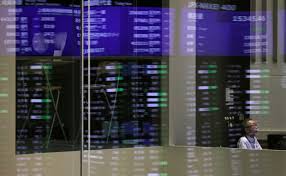Stock Prices Have Plummeted. That Doesn’t Make Them Good Buys

The business press and Wall Street money managers are advancing lots of plausible reasons for the stock market’s steep slide, ranging from the menace of more Fed rate hikes to an escalation of trade tensions with China to slowing global growth. A much simpler, and more likely explanation is getting scant attention: Equities have been extremely expensive for years, and the more overpriced they grew, the more vulnerable they become to the kind of severe reversal that’s now underway. Put simply, super-high valuations sow the seeds of super-sharp corrections.
In fact, the markets bring to mind those Looney Tunes cartoons where Wile E. Coyote hovers in mid-air over a gigantic chasm, arms and legs whirling helicopter-style, seemingly defying gravity, then suddenly realizes he’s run off the cliff, and plunges to the desert floor.
Until recently, U.S. stocks were just too pricey to offer anything but paltry future returns. So now, the crucial question is whether the big drop has transformed equities into a bargain, a New Year’s refrain on Wall Street. It’s true that the 15% selloff from the market’s September peak has substantially improved the dividend picture, raising the average yield of stocks in the S&P 500 from 1.7% to over 2%. And that benchmark index’s price-to-earnings ratio, based on trailing, 12-month GAAP earnings, is 17.9 today, which looks a lot more attractive than the 22 multiple at the peak.
Still, the official ratio is misleading. Stocks are a lot more expensive than they appear for one simple reason: earnings are highly inflated, raising the denominator, and artificially shrinking the PE. Three quarters of 2018 profits are already on the books, and adding analysts’ estimates for Q4, S&P forecasts that earnings for the S&P 500 will reach $ 141 per share for the full year. That’s a 28.3% increase over 2017, which was itself a record year. And analysts are projecting another 10.8% profit increase for 2019.
Overoptimistic on earnings
An almost 11% increase, or anything significantly greater than zero, is highly unlikely for next year. The reasons are two-fold. First, earnings are already hovering, Wile E.-like, at unsustainable levels. According to the Commerce Department, corporate profits now account for 9.8% of GDP, 3 percentage points above their historic average. S&P reports that operating earnings for the first three quarters of 2018 stood at 11.7%, far exceeding the 9% norm since the recovery began in 2010.
(Read “The Profit Boom Will Stumble, And Hobble the Bull.”)
After years of paying essentially flat wages, companies are now finding they need to raise pay to attract workers. The fall in oil prices is hammering profits at energy companies. The reduction in the corporate tax rate from 35% to 21% last year gave earnings a one-time lift that won’t recur in 2019. Even Wall Street is acknowledging reality: In December, analysts reduced consensus 2019 profit estimates for more than half the companies in the S&P 500.
Second, delivering another double-digit profit increase would require a return-on-investment bonanza that’s mathematically impossible. Let’s unpack drivers of growth in earnings-per-share. Today, the S&P stalwarts are paying approximately 40% of their earnings in dividends. Buybacks account for another 25%, and they’re reinvesting the remaining 35% in new plants, software, and other projects that fuel future growth in profits.
Not investing enough to grow
So let’s treat S&P as one big company, and examine the kind of returns those retained earnings need to generate the double-digit gains in earnings. In our example, what we’ll call S&P Enterprises has 100 shares outstanding, and the shares sell at $ 100 each, for a market cap of $ 10,000. Earnings per share are the inverse of the S&P PE of 17.9, or $ 5.6 per share, and total earnings are $ 5600. Analysts are forecasting that in 2019, S&P Enterprises will raise EPS by 10.8%, of from $ 5.60 to $ 6.20 per share.
S&P Enterprises is paying a dividend amounting to 40% of those 2019 earnings, or $ 2480. That’s a decent yield of 2.5%, but that money goes straight to shareholders, and not to growth-building investments.
Buybacks help a bit. S&P Enterprises devotes one-quarter of that $ 6200 in profits––$ 1550––to repurchasing its shares. Hence, the purchases will lower the share count by 1.55%, from 100 to 98.45 shares, raising existing investors’ ownership share in the business. But to reach that 10.8% return, the big workhorse has to be profits reinvested in the business. And I mean big. S&P Enterprises is plowing 35% of its earnings, or $ 2170, into growth projects. Even with the lower share count, to get to $ 6.20 in earnings-per-share, S&P Enterprises needs to generate a 23% return on reinvested earnings, raising the number from $ 2170 to $ 2670.
The point is that corporate America is depending on 35% of its profits––the dollars reinvested in plants, warehouses and the like––to generate almost all of future growth in total profits. Those kinds of gains are only possible when corporate America is roaring back from economic disaster. They’re impossible starting from today’s already record profit gains, when labor costs and interest costs are accelerating.
Reaching double-digit returns on investment from these already incredible levels of profitability is a fantasy, like imagining the day when Wile E. outfoxes the Roadrunner.

